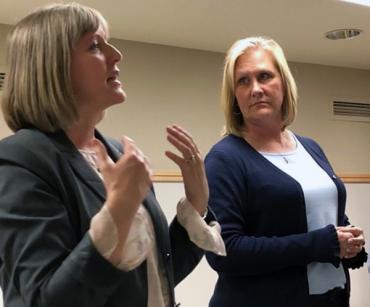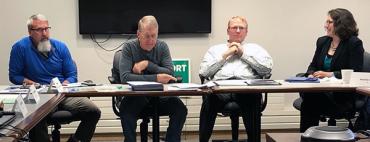Foreshadowing great things ahead, leaders of AFT Public Employees from across the country swapped stories of organizing successes last week, starting with the merger of Montana’s two largest public employees unions—the AFT-affiliated MEA-MFT and the independent Montana Public Employees Association. The merged union has adopted a constitution, held its first conference and plans to celebrate its first official day as the Montana Federation of Public Employees on Sept. 1.
“One thing we’ve done successfully is that there’s no distinction between members, no meetings of only teachers or only public employees,” newly elected MFPE President Eric Feaver told members of the AFT PE program and policy council meeting in Helena May 17-18. “When we call a meeting, we invite all the members who live in that region. That idea is beginning to catch on.”
Feaver, who is also an AFT vice president, noted Montana’s powerful history of unionism. The state’s teachers began organizing themselves in 1882, seven years before statehood. “This is a union state,” Feaver said. “It’s always been a union state.”
PPC chair and state Sen. Jill Cohenour (above, left) said that MFPE, together with the AFT-affiliated Montana Nurses Association, will represent about 30,000 members, or more than half of Montana’s AFL-CIO membership. Cohenour described union socials and Facebook Live meetings that are drawing in new members for solidarity and activism.
Montana’s surge in member engagement is mirrored in AFT locals all over the country, whose latest mobilizations are inspired by Janus v. AFSCME Council 31, a case before the U.S. Supreme Court that could, in effect, turn every state into a so-called right-to-work state for public sector employees. Feaver said Montana workers “don’t take kindly to Janus.” He described the governor’s friend-of-the-court brief in the case pointing out that state matters should be managed at the state level, not by federal courts.
Other locals have ramped up member mobilization, too. The New York State Public Employees Federation, for example, has created a member toolkit and held door-knocking campaigns so that members can raise awareness about Janus and persuade agency fee payers to become union members.
In Connecticut, the statewide “U and I in Union” campaign has steadily drawn fee payers into the AFT and prompted members to sign “recommit cards” promising to continue their memberships, according to Ed Leavy, president of the State Vocational Federation of Teachers and an officer of AFT Connecticut.
PPC leaders discussed the recent member mobilization training in Alaska and an upcoming mobilization in Maryland to be led by the City Union of Baltimore.
One part of these member engagement drives is the status of data collection in each affiliate, a hot topic at the meeting. Another issue is how well or poorly our members are treated as professionals in their fields of expertise, a wide-ranging discussion led by AFT Executive Vice President Mary Cathryn Ricker. She pointed out that there’s no longer any such thing as a low-skilled worker. Gary Feist, vice president of public employees for North Dakota United, provided an example of the need to fill public sector jobs with highly skilled professionals. In the state department of revenue where he works, thousands of fraudulent tax returns are received every year, “and you have to identify and stop them before they’re paid because after that, it’s too late.”
In related news, Steve Porter, retired director of AFT Public Employees, has been named director of Public Services International’s subregion for North and Central America. He will work out of the AFT offices in Washington, D.C.
[Annette Licitra/photos by Chris Runge]


